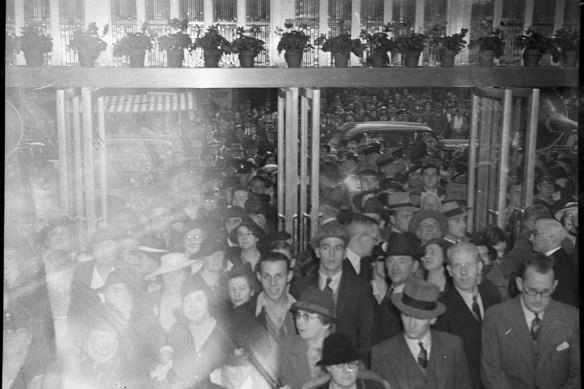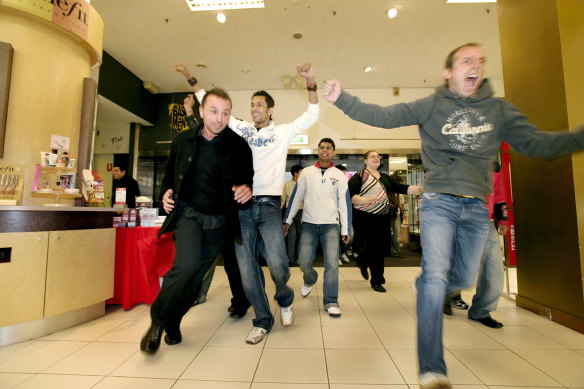
“Key to delivering this experience is our ongoing program of retail network optimisation, through investment in our stores and right-sizing,” the spokesperson said.
Walker said bricks-and-mortar stores were becoming less about the product and more about the experience.
“People go there for things like show-rooming, which is to talk to staff, touch products, get expertise. Increasingly, retailers are finding that customers are buying their product online prior to even going into the shop, or buying online after they’ve been to the shop.”
Among the world’s oldest department stores
Luxury department store chain David Jones was founded by Welsh-born immigrant David Jones in 1838. It is older than Harrods and Selfridges in London, Bergdorf Goodman in New York and Galeries Lafayette in Paris.

The opening day of a David Jones store in Sydney in May 1938. Credit: Sam Hood/Mitchell Library, State Library of NSW
South African retailer Woolworths Holdings (no relation to the Australian supermarket) bought the department store for $2.1 billion in 2014 and sold it to Sydney-based private equity firm Anchorage Capital eight years later for a fraction of the price at $100 million.
David Jones has 43 stores across the country. Myer has about 55. Myer’s recently departed chief executive, John King, oversaw a strategy that began in 2017 to save on rent and slash costs and bring the then-struggling retailer back to profitability.
IBISWorld estimates David Jones will notch $2.2 billion in revenue this year and Myer will post $2.8 billion, as department stores recover modestly after being hamstrung by lockdowns and the lengthy pause in tourist flow.
“Despite efforts to cut costs and revive foot traffic, David Jones’ profitability has waned,” says an IBISWorld industry report.
As cost-of-living pressures rise, consumers have pulled back on spending and traded down on discretionary purchases for more affordable alternatives. The likes of Amazon and ultra-cheap fast fashion giants Shein and Temu have also rapidly gained market share in Australia.
Loading
Myer, which has been downsizing for years, has shut a swath of its stores including Blacktown, Wollongong, Orange and Hornsby in NSW; Knox and Frankston in Victoria; Brisbane CBD; Belconnen in the ACT; and Colonnades in South Australia.
Last year, Myer refurbished its Tea Tree Plaza store in South Australia and reopened as three instead of four floors. It also renovated and gave up some floor space in its Chermside store last October.
RetailOasis co-director Trent Rigby believes Myer’s new boss, former Qantas Loyalty head Olivia Wirth, will make announcements soon about store footprint.
Rigby said: “David Jones has a lot of greater brand awareness. But David Jones plays to more of an upmarket or premium customer, whereas Myer more plays around that middle ground. We just know from what we’ve seen – and we’re seeing this exact same thing play out overseas – is that that middle market department store is really getting pushed out of the market.”

Shoppers rushing into a Myer store for Boxing Day sales in 2016.Credit: Eddie Jim
“People are either going up; they either want to buy quality, or on the flip side, they want to buy value.”
Australia’s department store moves are part of a global trend, as the sector seeks to find the right model to cater for the increasingly online consumer. Rigby said the likes of Sears, Marks & Spencer and Nordstrom had been busy closing stores.
Australia’s two main department store chains will need to do better at capturing the younger demographic. “They’re not really talking to those digital natives like Gen Y or Gen Z,” said Rigby.









 Add Category
Add Category